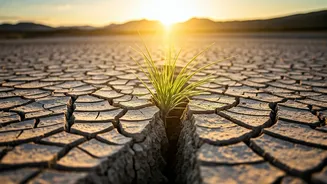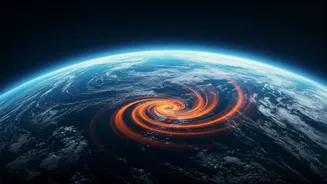A Concerning Milestone
The atmosphere of Earth has recently recorded a startling increase in carbon dioxide (CO2) levels. The latest data reveals that atmospheric CO2 has soared
to 424 parts per million (PPM). This marks the most considerable yearly jump ever observed. This unprecedented rise of CO2 concentrations is a stark reminder of the intensifying impacts of human activities on the environment. The scientific community closely monitors CO2 levels, as these measurements are essential indicators of climate change. The continuous increase in CO2 is primarily attributed to burning fossil fuels, deforestation, and other human-driven activities that release greenhouse gases into the atmosphere. The impact of this increase has far-reaching implications, including rising global temperatures, altered weather patterns, and increased frequency of extreme weather events. The scientific data available underscores the need for immediate and concerted global efforts to reduce greenhouse gas emissions and mitigate the effects of climate change.
Decoding the Data
The measurement of 424 PPM represents the concentration of CO2 in the atmosphere. This means that for every million air molecules, 424 of them are CO2 molecules. While this number might seem small, the impact is significant when considering the scale of the atmosphere and the effect CO2 has on trapping heat. The increase observed is not just a gradual progression but a rapid acceleration. The 'biggest yearly jump ever' is particularly concerning, as it indicates that the rate at which CO2 is accumulating is increasing. This acceleration means that the climate is changing faster than anticipated, leading to more immediate and severe consequences. The continuous and accelerating increase highlights the urgency of implementing strategies to reduce emissions. It also shows the importance of investing in technologies that capture CO2 from the atmosphere or prevent it from being released in the first place. The data points show a clear trend, underscoring the urgent need for action.
Impact and Consequences
The rise in atmospheric CO2 levels has various consequences that directly affect the environment and human societies. One primary effect is the warming of the Earth's climate. CO2 acts as a heat-trapping gas, causing global temperatures to rise. This leads to melting glaciers and ice sheets, contributing to rising sea levels, and threatening coastal communities. Moreover, the increase in CO2 can intensify extreme weather events. This includes more frequent and severe heat waves, droughts, floods, and storms. These events cause damage to infrastructure, disrupt agricultural production, and threaten human lives. The oceans also absorb a significant amount of CO2, leading to ocean acidification. This process harms marine life, particularly organisms with calcium carbonate shells or skeletons. This includes coral reefs, which are vital for marine biodiversity. Addressing these consequences requires a holistic approach, including emission reductions, adaptation strategies, and international cooperation. The impacts are numerous, requiring urgent solutions.
The Path Forward
Addressing the rising CO2 levels requires comprehensive strategies. This encompasses transitioning from fossil fuels to renewable energy sources, such as solar and wind power. Simultaneously, increasing energy efficiency and implementing carbon capture technologies are essential. Reforestation efforts play a crucial role as trees absorb CO2 from the atmosphere, thus reducing its concentration. International collaboration is critical, as climate change is a global issue that necessitates worldwide action. Governments, businesses, and individuals all have roles to play in mitigating climate change. Policymakers should introduce and enforce regulations that promote sustainable practices. Businesses can invest in green technologies and adopt environmentally responsible operations. Individuals can reduce their carbon footprint by making conscious choices. These choices include reducing energy consumption, adopting sustainable transportation methods, and supporting policies that address climate change. Collective and sustained efforts are crucial to combatting this challenge.













